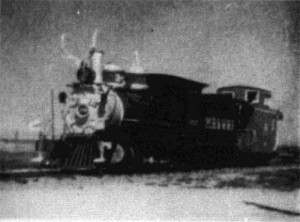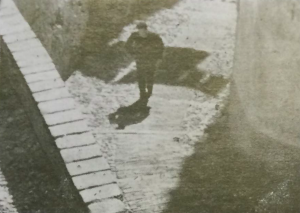"An intertitled travelogue film of a trip to Australia starts with a map showing the journey from London to Australia, followed by views at different stages of the route" (SASE online).
"Edited film used by an amateur travel-lecturer documents travel in western and southwestern United States beginning at a rodeo in Phillipsburg, Kansas (trick riding, lassoing jack rabbits, roping calfs, wrestling steers, horse races, bucking broncos and bucking steers as well as scenes of an airplane flyover and of an airplane crashing which possibly was a stunt) and continuing to Black Hills, South Dakota (forest scenery and ca. 1927 construction of Mount Rushmore--blasting off cliff face, scaffolding, men working and completed monument). Shown are roadside scenery, railroad tracks, men cleaning railroad tracks with hose and tank on small train car on the way to an unidentified mountain fishing camp possibly in Colorado (canoeing, fishing in stream, and a smokehouse) and a mountain farm where colts are branded. Cog railway is taken up to Pike's Peak. Travels continue to to the Southwest (unidentified southwestern town possibly Santa Fe with adobe buildings and men and children in Mexican dress singing and playing guitar, American Indian dance performance indoors possibly Zuni, parade of American Indians in unidentified city perhaps Gallup and Navajo band. Scenes of the southwest continue with Navajo in Canyon de Chelly (hogans and herding sheep), prehistoric archaeological sites (Mesa Verde, Chaco Canyon another unidentified cliff dwelling possibly Montezuma's castle) and Taos Pueblo. Film records American Indian dances at a gathering of Indian tribes possibly at Gallup, intertribal horse races and women's tug-of-war. Hopi are shown dancing at Hopi. Also shown are Indian women (possibly Apache or Navajo) and children together and children in cradleboard and the Navajo reservation (hogans, women spinning and weaving under a ramada, herds of sheep and goats and "dipping sheep"). Natural wonders of Grand Canyon, Monument Valley and Rainbow Bridge National Monument are featured.Travel continues to Yellowstone National Park, California (scenery, black bears, hot springs and geysers) and onto the California coast possibly Monterey (seals on rocks). Also shown are an unidentified town with oil pumps and derricks and people waterskiing" via the Human Film Studies Archives, Smithsonian Museum.
A travelogue of a cruise in an unknown area of the Mediterranean Sea.
"comprises various events of 1932, including shots of the speedboat, Miss England III on Loch Lomond, and a very complete record of the Ulster T.T Motor Race. The reel has been very much in demand and can be hired by anyone, the charge being 4s. for the night" (HMHT 1933: 335).
"Made by F. D. Koehler, jr., ACL, The Mississauga Canoe Trip is a fine example of what the movie maker can accomplish on a hunting trip in capturing a picture that has both good photography and an interesting story presentation. The fact that a tripod was added to the duffel did not daunt this cinematic hunter, and the result is refreshingly rock steady pictures that leave nothing to be desired. Perfect exposure, for the most part, and some excellent lighting show that the maker had an eye for the essentials of good picture making. A knowledge of what makes a good screen picture is demonstrated in the many effective closeups throughout the film. An excellent job of amateur titling is another feature that places this film in a high category for vacation films." Movie Makers, Dec. 1934, 534.
"Exciting times at Southport, as racing cars hurtle around a course laid out on the sands, in this short reel by filmmaker George Jesse Turner. The town has an impressive history of motor racing - before the famous Brooklands circuit opened in 1907, cars raced each other through Southport streets, though this proved too disruptive, and the sport was wisely relocated to the town's sandy beaches." (BFI Player)

"In Narrow Gauge Kingdom Roger H. Klatt presents an ambitious and highly successful documentary study of the rapidly vanishing narrow gauge railroads of the Far West—and of Colorado in particular. Excellently photographed and edited, Narrow Gauge Kingdom gives rewarding evidence of high-caliber research carried out by a genuine railroad enthusiast. Both picture-wise and in well-delivered narrative, Mr. Klatt has delved deep into the flavor of his subject, producing a film which, despite is length, is interesting throughout and of lasting historical significance. A newcomer to the Ten Best competitions Mr. Klatt has used the medium of the motion picture with rare competence. Not only has he effectively pinned down the dramatic possibilities inherent in his subject, but he has utilized the mountain background of Colorado to fine advantage. Apparently neutral between the proponents of magnetic stripe or tape recording, Mr. Klatt has used both, skillfully putting the narration and railroading sound effects on magnetic stripe and and effectively indigenous guitar accompaniment on a separate tape!" PSA Journal, Jan. 1955, 48.

"a sogg. lungh. norm." Feature fiction film
"La Nave, realizzato da Giovanni Paolucci, collaboratore tecnico Pietro Portalupi. Il difetto di questo film consiste nello scenario, nel non aver cioè gli autori trattato il tema in forma meno dispersiva, il protagonista, uomo disorientato ed inutile, senza uno scopo nella vita trova, col lavoro in una nave che alla fine viene varata e nell'atmosfera del fascismo, la sua strada. Un tema simile poteva essere trattato retoricamente o in modo più semplice e persuasivo; gli autori si sono attenuti alla via di mezzo, riuscendo talora in buone sequenze, talora in sequenze dall'azione dispersiva. Migliore è la prima parte, quando Paolucci descrive il rapporto dell'uomo col mare, e prima, la sua solitudine; la fotografia è in queste scene piuttosto notevole."
"The Ship (La Nave), directed by Giovanni Paolucci, technical collaborator Pietro Portalupi. The defect of this film is in the scenario and in its authors not treating the subject in a less unorganized way. The protagonist, a disoriented and useless man, without a purpose in life, finds his way by working on a ship that is eventually launched and in the atmosphere of fascism. Such a theme could have been treated rhetorically or in a simpler and more persuasive way; the authors stuck to the middle ground, succeeding sometimes in good sequences, sometimes in sequences with dispersive action. The first is the best part, when Paolucci describes the man's relationship with the sea, and before that, his loneliness; the photography is quite remarkable in these scenes."
—Il ventuno 28 (Review of the G.U.F. of Venice), May 1935, p. 17-18
"a war film… deals principally with submarines… an almost full-sized submarine was built out of sheet-iron and wood; the very convincing interior of the aforesaid submarine was built in a garage; and merchant ships (models) were ruthlessly blown up by a torpedo (ditto, bought at Woolworths), which zipped through the water (by a string wound on a Kodak rewind) and left a wicked-looking wash (milk)" (R.S. 1932: 9).
Total Pages: 12